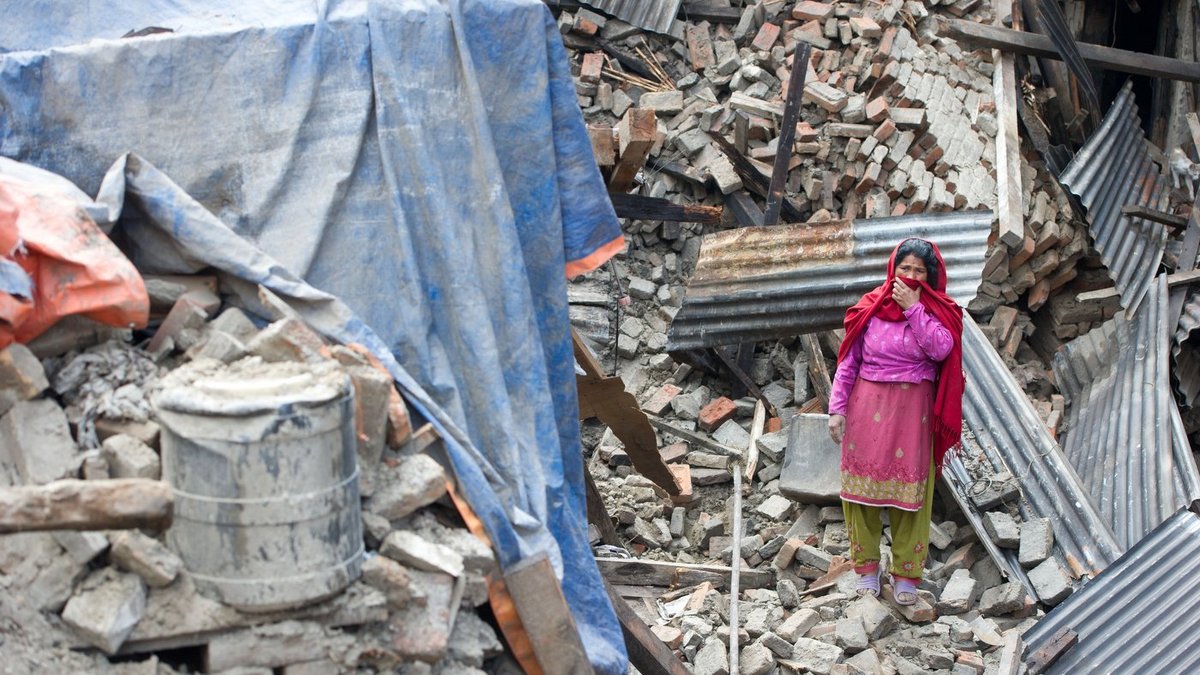Disasters

Disasters worldwide
As a result of natural disasters such as floods, earthquakes or hurricanes, thousands of people lose their homes or even their lives every year.
Help supports those affected by disasters with fast and efficient emergency aid. We also promote subsequent reconstruction and help people in risk areas to prepare for future disasters.
What is a natural disaster?

Natural disasters are very violent and unusual natural events that lead to many deaths and injuries. They usually cause severe damage to buildings and infrastructure, destroy water sources and devastate agricultural land. After such a disaster, the people affected are often no longer able to help themselves and are dependent on international support.
Natural disasters usually occur unexpectedly, which makes them particularly dangerous. Although there are early warning systems that can detect natural events such as earthquakes, these usually only kick in immediately before the disaster strikes. In this short time, only warnings can be issued and initial protective measures initiated.
The consequences of natural disasters are particularly devastating for people in economically weak countries. Many families lack the means to prepare for an emergency or to rebuild their homes after a disaster. In addition, droughts, storms and floods often cause crop failures, resulting in hunger crises.
Different types of natural disasters
There are very different types of natural disasters. These include earthquakes, floods and volcanic eruptions, for example, but also severe storms, landslides, droughts and forest fires. Seaquakes, which can lead to huge waves known as tsunamis, are also particularly dangerous. In terms of fatalities, the 2004 tsunami in south-east Asia was the worst natural disaster of all time. More than 230,000 people lost their lives and around 1.7 million were left homeless.
While natural disasters only occur very rarely in most countries, some regions are exposed to a particular risk. For example, earthquakes and volcanic eruptions can occur wherever continental plates collide. However, they occur most frequently along the Pacific Ring of Fire, i.e. on the west coast of South America and in eastern Asia and Australia. Tropical cyclones occur mainly in East Asia, Oceania, South East Africa and southern North America. The dry regions of the African continent, on the other hand, are particularly susceptible to severe droughts.
Disasters and climate change

The number of climate-related disasters has increased significantly in recent decades. According to a UN study, weather extremes such as storms, floods and droughts in particular have not only been occurring more frequently since 1960, but have also become more intense and therefore more devastating. In contrast, the frequency of endogenous or tectonically caused disasters such as volcanic eruptions or earthquakes has remained the same. It is therefore considered certain that the increase in natural disasters is largely due to man-made climate change.
Climate change primarily intensifies the factors that promote natural disasters, rather than being responsible for individual events itself. For example, the increase in greenhouse gases in the atmosphere is causing global temperatures to rise and heatwaves to become more frequent and more intense. As a result, the risk of devastating forest fires and droughts is increasing.
The warmer air can also absorb more moisture, which changes precipitation patterns. Rain often remains absent for longer periods, increasing the risk of droughts. As soon as the cloud masses rain down, they produce extreme precipitation within a short period of time. The parched soils cannot absorb the masses of water, resulting in flood disasters and landslides.
Scientific studies also suggest that the warming of the oceans also increases the risk of severe tropical storms and hurricanes. The storms are not necessarily occurring more frequently, but are becoming more violent and therefore more destructive. Cyclone Freddy, for example, which swept across Malawi and other south-east African countries in early 2023, is considered the longest-lasting tropical cyclone ever recorded.
Natural disasters: Threat to poor countries

Natural disasters repeatedly cause severe damage, particularly in the countries of the Global South. Large sections of the population here live in abject poverty and have no way of preparing for disasters. Many live in simple dwellings that cannot withstand storms or earthquakes. As a result, the death toll is often particularly high. In addition, local institutions are usually not sufficiently prepared for natural disasters and require international support in the event of an emergency.
Extreme weather events such as droughts or floods in particular cause crops to fail and livestock to die. People lose their food and livelihoods, which is why natural disasters are often followed by hunger. In some cases, entire regions are dependent on humanitarian aid. After disasters, many people are forced to leave their homes, often even their country.
Our aid after natural disasters

As soon as a natural disaster occurs, our full attention is focused on the affected region. In close cooperation with our global network, we assess the situation on the ground and prepare initial emergency aid measures in the shortest possible time. In this way, we can provide effective help and support people with what is really needed.
In an acute crisis, Help distributes vital relief supplies such as food, blankets and tents. To prevent the spread of infectious diseases, we distribute hygiene products such as soap and diapers in the affected areas and improve access to clean drinking water and sanitary facilities.
As soon as the first emergency aid phase has been completed, Help sets the course for sustainable reconstruction. In the spirit of helping people to help themselves, we support those affected in repairing their homes themselves, distribute building materials and tools and pass on specialist knowledge. In areas that are repeatedly affected by natural disasters such as earthquakes or tsunamis, we also ensure that buildings are particularly stable and safe. We also strengthen disaster preparedness and show people how they can better prepare for future disasters.
The aim of our efforts is to ensure that those affected by natural disasters recover quickly, are able to resume their lives and are prepared for the next disaster.




